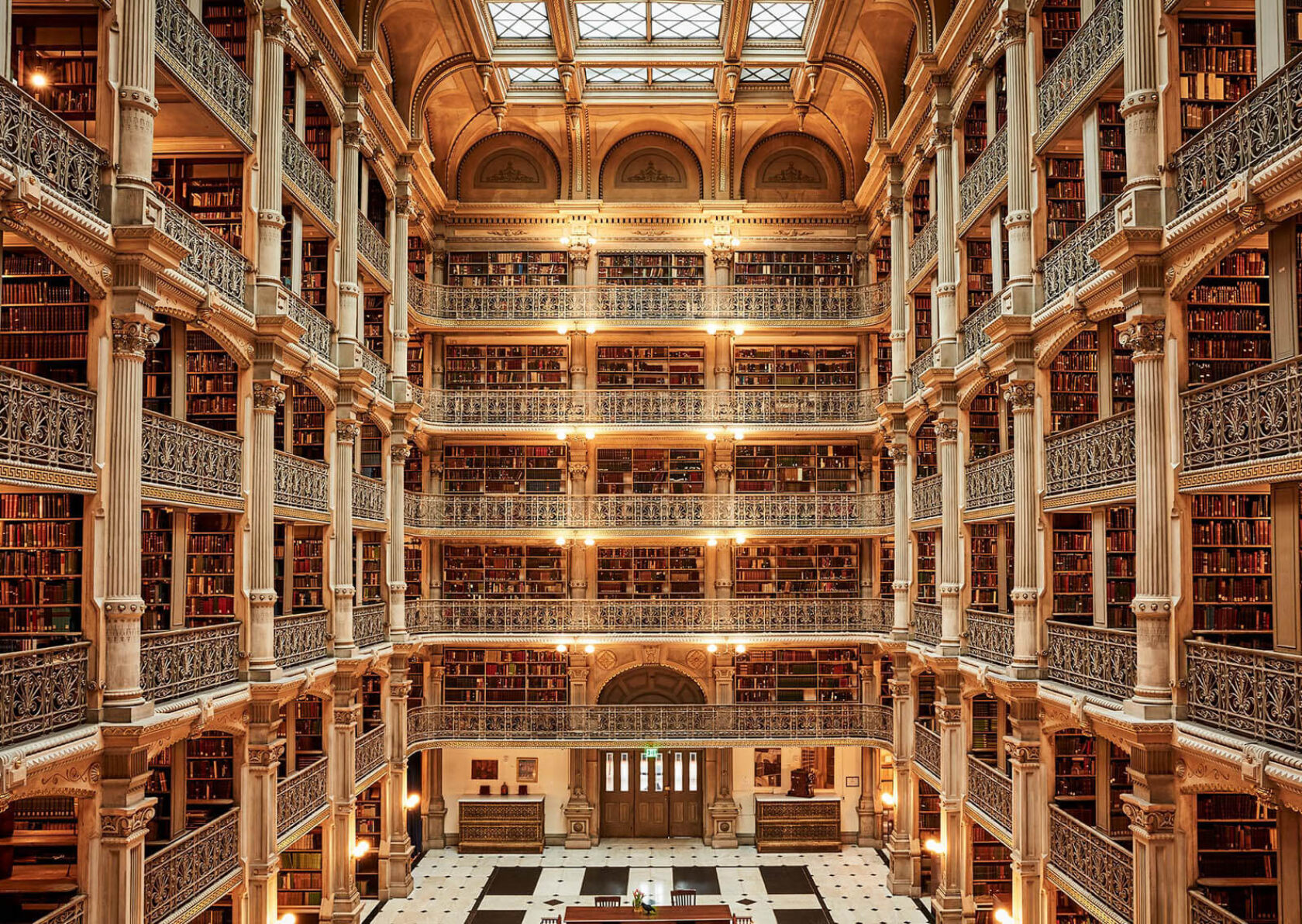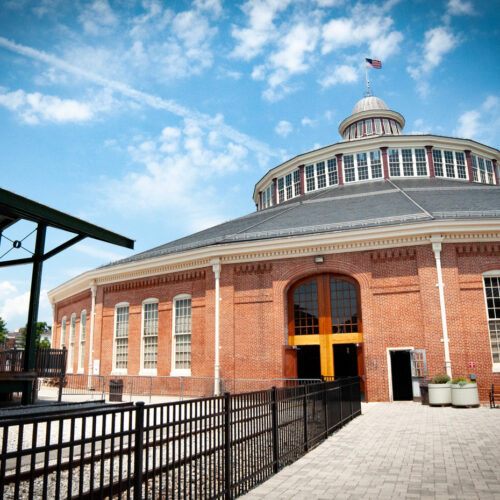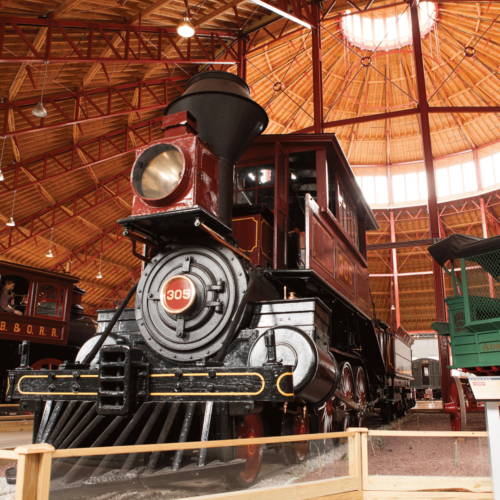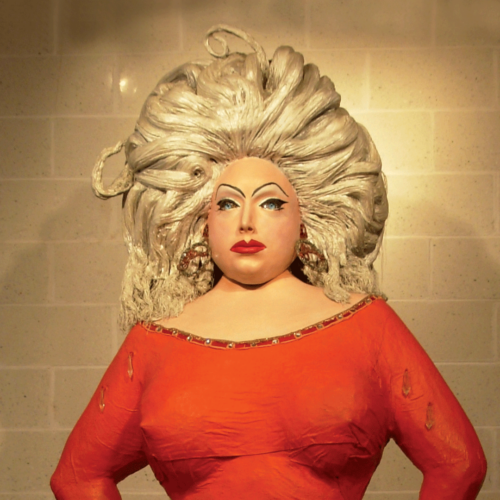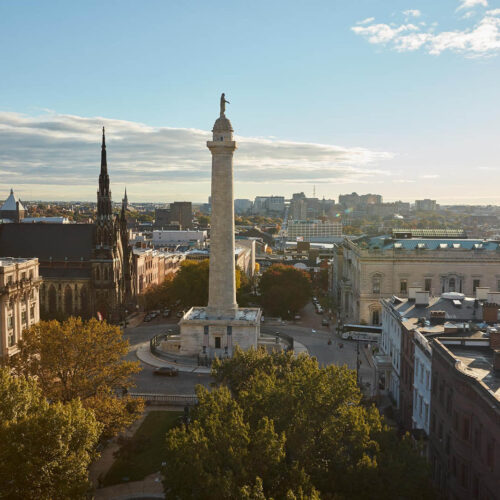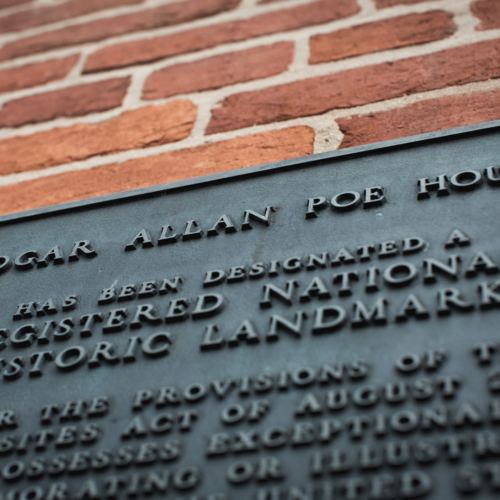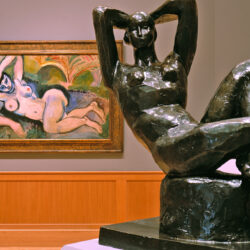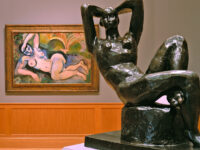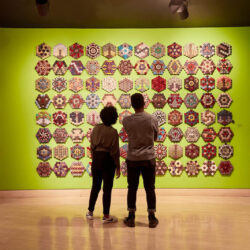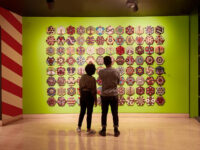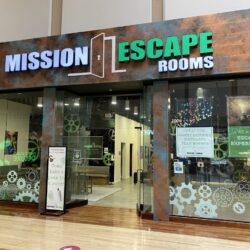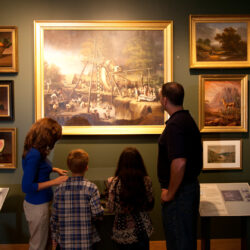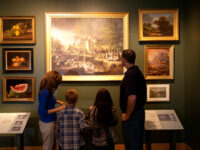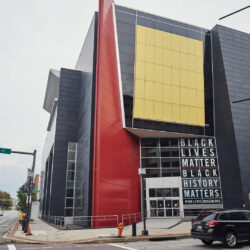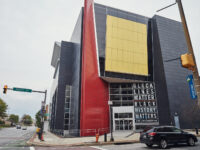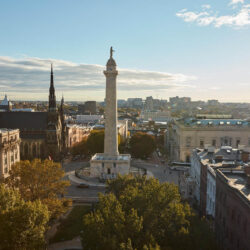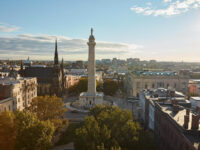Baltimore: A Book Lover’s Dream
Explore Baltimore's literary events, take a literary history tour and check out the places that inspired Baltimore's most famous literary residents.
One of Baltimore’s many mottos collected over the years is “The City That Reads.” Originally coined decades ago by former Mayor Kurt Schmoke to encourage literacy, today the slogan resonates in many other ways. Once home to famous writers like Edgar Allan Poe, F. Scott Fitzgerald and H.L. Mencken, there is no shortage of historic sites and can’t-miss attractions. The city has long been home to iconic public libraries, most notably the George Peabody Library and the Enoch Pratt Free Library, and Baltimore’s modern cultural renaissance has also fostered a thriving bookstore community, with must-visit shops found all over the city, and literary-inspired restaurants—we even named our NFL team after a famous poem (Edgar Allan Poe’s “The Raven”). Check out our list of literary hot spots to discover in Charm City.
Literary Landmarks
The Edgar Allan Poe House and Museum
Edgar Allan Poe once lived at this house-turned-museum with his family for years. It has been very well preserved from its original state, so you can walk on the same floors and stairs and wander within the original plaster walls and woodwork that Poe once did. See the writing desk and chair where he created some of his early works, among other significant artifacts.

Step inside one of Baltimore’s most iconic rowhomes, Edgar Allan Poe’s house on North Amity Street.
Emmanuel Episcopal Church
The first woman in history to receive a Pulitzer Prize for poetry, Edna St. Vincent Millay, frequently read during meetings of the Maryland Poetry Society at the Emmanuel Episcopal Church in Mount Vernon. Millay championed the plight of women and the oppression of traditional gender roles, and was known as “the embodiment of the liberated woman of the 1920s.”
F. Scott Fitzgerald’s House
F. Scott Fitzgerald, writer of great works like “This Side of Paradise” and “The Great Gatsby,” went through a dark period in Baltimore. This house in Bolton Hill is the last place he lived with his wife Zelda. Writer H.L. Mencken wrote in his journal in 1934: “The case of F. Scott Fitzgerald has become distressing. He is boozing in a wild manner and has become a nuisance.” Although the house is not open to the public, you can see a blue historical designation on the outside of the rowhome.
Gertrude Stein’s House
Although Gertrude Stein and her brother Leo only lived in this location for about six years, the influence of life in Mount Vernon introduced Stein to a variety of people and perspectives that influenced much of her later work. Stein studied medicine at Johns Hopkins University for three years and later claimed Baltimore as her “place of domicile” in her will despite her 39-year absence from the city.
Walters Art Museum
The Walters Art Museum’s extraordinary collection chronicles the art of the book for more than 1,000 years. The collection includes more than 900 illuminated manuscripts, 1,250 of the first printed books, and an important collection of post-1500 deluxe editions. Books come from all over the world to live in the Mount Vernon museum, and include first-printed editions of ancient texts by great thinkers such as Aristotle and Euclid, diaries written by Napoleon, and intricate bindings crafted by Tiffany.

Literary history lives among the Walters Art Museum’s expansive collection.
The Clifton House
Lucille Clifton wrote six collections of poetry, won two National Endowment for the Arts fellowships and served half her tenure as Maryland’s poet laureate in her Baltimore home before it was foreclosed upon in 1979. In 2019, her daughter Sidney bought back the house and turned it into a workshop and sanctuary for both established and up-and-coming writers and artists, just as her mother had done.
H.L. Mencken House
H.L. Mencken lived in Baltimore for more than 45 years and wrote for many city publications, including The Baltimore Sun. He was given the nickname the “Sage of Baltimore.” He lived in this brick rowhouse with a view of Union Square from 1883 until his death in 1956. It was recently renovated to become a museum dedicated to the author’s life and works.
John H.B. Latrobe House
In this house, on an evening in October of 1883, Latrobe and two other Baltimore writers pored over manuscripts submitted in a literary contest sponsored by the “Baltimore Saturday Visitor.” Their unanimous choice for the best prose tale was “MS. Found in a Bottle,” by an unknown, penniless author named Edgar Allan Poe. The $50 cash prize helped launch his literary career. The home in Downtown Baltimore is now a private residence but it signifies a milestone in Poe’s career.
Mount Vernon Place United Methodist Church
This Victorian Gothic church in Mount Vernon was built at the site that once housed the mansion of Elizabeth Phoebe Key, the daughter of Francis Scott Key, who penned “The Star-Spangled Banner.” Francis Scott Key died in his home, and a plaque observing his death is on the southern exterior church wall.
Westminster Hall & Burying Ground
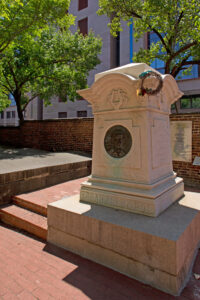
Visit Edgar Allan Poe’s final resting place right here in Baltimore.
Westminster Hall, one of the most historic half-acres in Downtown Baltimore, is an architectural landmark. The imposing brick church was built in the early 1850s and several historical figures are buried here, including the famed poet Edgar Allan Poe and his wife and mother-in-law. Inquire about arranging a tour of the grounds and catacombs.
Douglass Place
Frederick Douglass’ story as an abolitionist and writer was heavily influenced by his time in Baltimore where he worked at the shipyards in Fell’s Point before escaping to freedom in 1838. Years after he transformed the nation with his ideas for reformation, Douglass returned to Baltimore to build a row of houses for African American renters—brick-and-mortar examples of his commitment to creating stability and community for African Americans in the years following the Civil War. His “Douglass Place” homes still stand today, with a commemorative plaque next to the front door where Douglass lived, at 524 S. Dallas Street.
Literary-themed Restaurants and Bars
Annabel Lee's Tavern
Named for one of Edgar Allan Poe‘s poems, this intimate Canton bar pays homage to the writer with dim lighting, gothic décor and hand-painted walls sprawled with lines of poetry. Check Annabel Lee‘s menu for cocktails titled “The Raven” and “Edgar.”
Apropoe's
Located inside the Baltimore Marriott Waterfront in Harbor East, Apropoe’s restaurant gives a subtle nod to the mysterious Edgar Allan Poe with its gothic feel. Dishes are classic American inspired by local fare with names like the Poe burger.

Literary excellence is all around Apropoe’s, from the atmosphere to the menu.
The Bluebird Cocktail Room
This literary-themed bar in Hampden features large communal tables, navy blue walls, a gas fireplace and a long bar for pub-style dining service. The cocktails (named after the likes of Ernest Hemingway and Virginia Woolf) are complemented by a menu of European bistro fare including charcuterie, fried sweetbreads and steak fries.
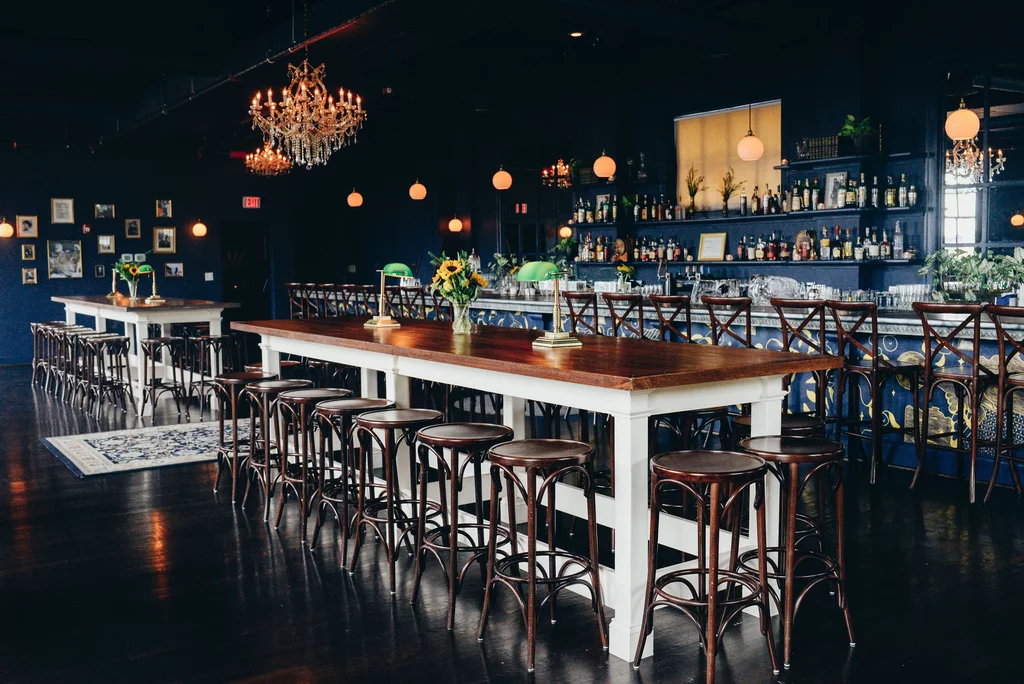
Literature is the backbone of this bar named after a poem by Charles Bukowski.
The Charmery
Stop by this handmade ice cream shop with locations in Hampden and Federal Hill for the Edgar Allan Poe-inspired flavor Tell Tale Chocolate. Stay for the other one-of-a-kind flavors like Old Bay caramel and Otterbein Sugar Cookie.

The story at The Charmery is always changing with new flavors to try every time you stop by.
The Owl Bar
F. Scott Fitzgerald and H.L. Mencken frequented this bar in the historic Belvedere Hotel in Mount Vernon. The hotel has since been converted to apartments and offices, but not much has changed since the Jazz Age (a term Fitzgerald coined) for The Owl Bar. The dimly lit bar features oak benches and stained-glass windows, and even an owl statue that signaled the police were near with the blink of its eyes during Prohibition.

Transport back in time for a night when you enjoy a cocktail in this local landmark.
Iconic Book Stores and Libraries
Atomic Books
“Literary finds for mutated minds” is the slogan of this independent Hampden bookstore, which also serves as the fan mail collection point for famed Baltimore native, artist and filmmaker John Waters. Atomic Books has been curating an eclectic selection of comics, books, zines and art for more than 20 years, and features a cozy bar in the back for hosting events.

It won’t be hard to get lost in the sea of titles offered at Atomic Books.
Bird in Hand
For an elevated bookstore and coffee shop experience, visit Bird in Hand in Charles Village. A sister store to The Ivy Bookshop, Bird in Hand has been perfecting its blend of “coffee, books and community” since 2016, and the vibrant space celebrates Charm City’s literary culture. Colorful must-read titles line floor-to-ceiling shelves, and other displays proudly feature goods from Baltimore makers and artists. The cafe serves Thread coffee, a woman and queer-owned company, as well as mouth-watering pastries from a cohort of local businesses.
The Book Escape
Don’t let the small storefront in historic Federal Hill fool you, The Book Escape has endless shelves of new, used and rare books. In addition to the ones on shelves, The Book Escape has more than 40,000 books in storage that are searchable through its website.
Everyone's Place African Cultural Center
For more than three decades, this Black-owned family bookstore has provided a place for Baltimoreans to gather and discover the different cultures of the African diaspora. Beyond books, Everyone’s Place sells clothing, fabric, jewelry, skin products and more. This Druid Hill destination also hosts events and invites local BIPOC artists to sell their work in-store.
Charlotte Elliott & The Bookstore Next Door
Stopping by Charlotte Elliott in Hampden is a must for antiques hunters and vintage lovers, while The Bookstore Next Door features two levels of books from fiction and science to poetry and cookbooks. Charlotte Hays, owner of Charlotte Elliott & The Bookstore Next Door, is the fourth generation of antiques and arts dealers in her family.
Drama MaMa Bookshop
Alisa Brock, owner and Drama MaMa in question, proclaims that we should “write…and then write some more.” Whether you’re creating the next great novel or scribbling a quick grocery list, Drama MaMa Bookshop supplies all the coolest stationery you’ll ever need. You can even customize your own journal, adding a logo or image and choosing the cover and paper type.

Because one can never have too many journals.
Enoch Pratt Free Library
The Central Library of the Enoch Pratt Free Library system takes up nearly an entire city block near Mount Vernon. An entire room at the library is dedicated to American writer H.L. Mencken, and there is also a collection of Edgar Allan Poe’s letters, poetry and photographs—and even a lock of his hair. One of the oldest free public library systems in the United States, there are 21 additional branches throughout the city and surrounding area.

The iconic Enoch Pratt Free Library is a must see for any literary lover.
George Peabody Library
This expansive library in Mount Vernon near the Washington Monument has been described as a “cathedral of books” and is considered to be one of the most beautiful libraries in the world. The Peabody Library‘s atrium is surrounded by six tiers of ornamental cast-iron balconies. The library’s 300,000 volume collection is open for perusal by the general public, and it houses an impressive amount of H.L. Mencken’s writings.
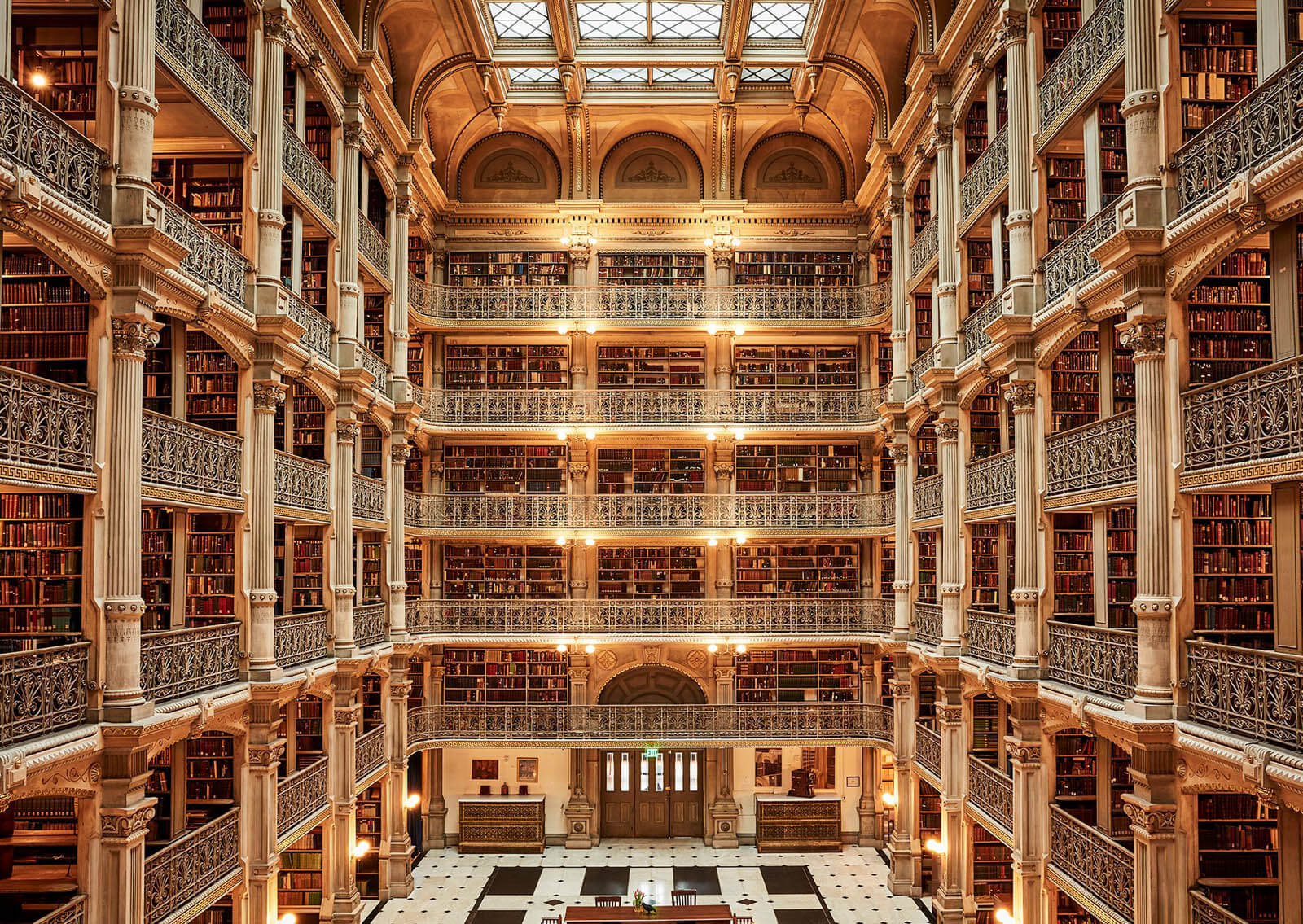
The Peabody Library, which opened its doors in 1878, stands six stories tall and houses more than 300,000 books.
Greedy Reads
Greedy Reads is a light-flooded book shop in Fell’s Point opened in 2018 by Julia Fleischaker, a Maryland native who moved back after working in publishing for nearly two decades in New York. A deep love of books and desire to create community drives her store’s ethos and programming, which includes a book club and discussions, and led to a second location in Remington.
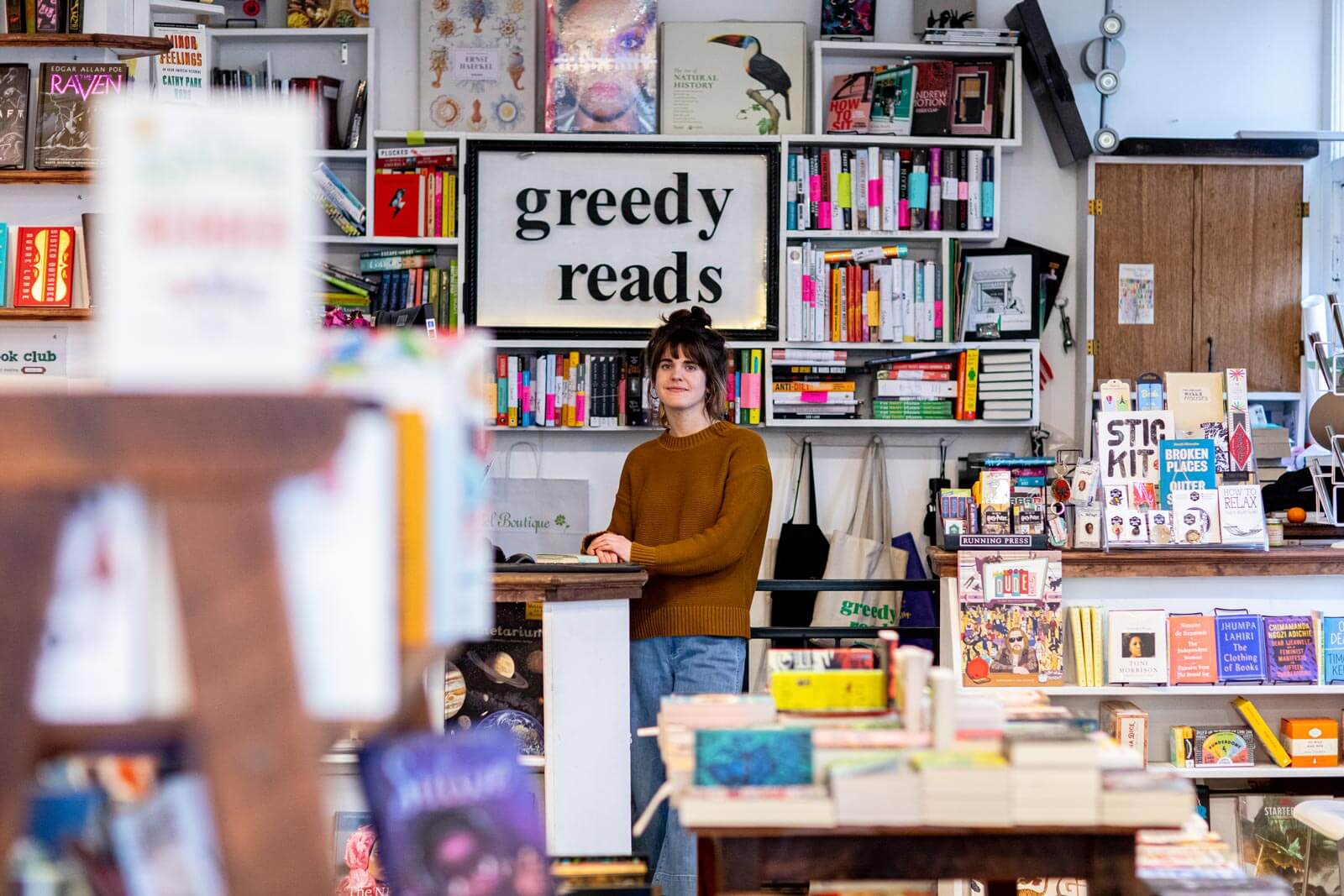
If you’re lucky, you might find Greedy Read’s shop dog, Audie, hanging out among the books.
Charm City Books
Located in the historic Seton Hill, neighborhood Charm City Books is a quaint and colorful reprieve from Baltimore’s busy downtown. You’ll find a comprehensive collection of modern fiction, memoirs and literary theory, including titles from Baltimore-based authors like D. Watkins and R. Eric Thomas, as well as selections for the little readers in your life. In addition to books, you’ll find stationary, stickers and Charm City souvenirs; you’re also likely to spy the owners’ four-legged friends roaming around the shop, helping customers select the perfect story!
The Ivy Bookshop
The Ivy Bookshop on Falls Road is a well-stocked independent bookstore with everything from bestsellers to niche titles. Find your perfect book with the help of knowledgeable book advisers, join a book club or meet national and local writers.
The Book Thing
Russell Wattenberg started collecting and passing out used books for free from the back of his van in 1999, which evolved to a warehouse in Baltimore’s Waverly neighborhood in 2005. The Book Thing is a staple for literary Baltimore, allowing people to take as many books as they like with no purchase or exchange necessary.
Literary History and Heritage Tours
Baltimore National Heritage Area’s Mount Vernon Cultural Walk
The Baltimore National Heritage Area provides 90-minute guided tours exploring the fine architecture and world-renowned institutions along Charles Street, one of the city’s main arteries and a National Historic Byway. Stops include the Walters Art Museum, Enoch Pratt Free Library and the George Peabody Institute. Guided tours generally depart from the Baltimore Visitor Center (401 Light Street in the Inner Harbor); maps for self-guided tours are also available for purchase there.
Annual Literary Events
International Edgar Allan Poe Festival and Awards
The annual International Edgar Allan Poe Festival and Awards coincides each year with Poe’s death day, October 7. The free outdoor event features Poe-themed performances, art, vendors and food across the street from the Poe House & Museum on North Amity Street where the poet once lived.

What better way to celebrate the macabre writer’s legacy than right in front of his former house?
Baltimore Book Festival
Celebrate all things literary during the Baltimore Book Festival, returning in 2024 after a four-year hiatus. The festival will be held in the Waverly neighborhood, which is home to multiple bookstores, including Urban Reads, Normal’s, Red Emma’s and Book Thing. More details are on the way, but this fall festival will likely include author meet-and-greets, panel discussions and a book fair!
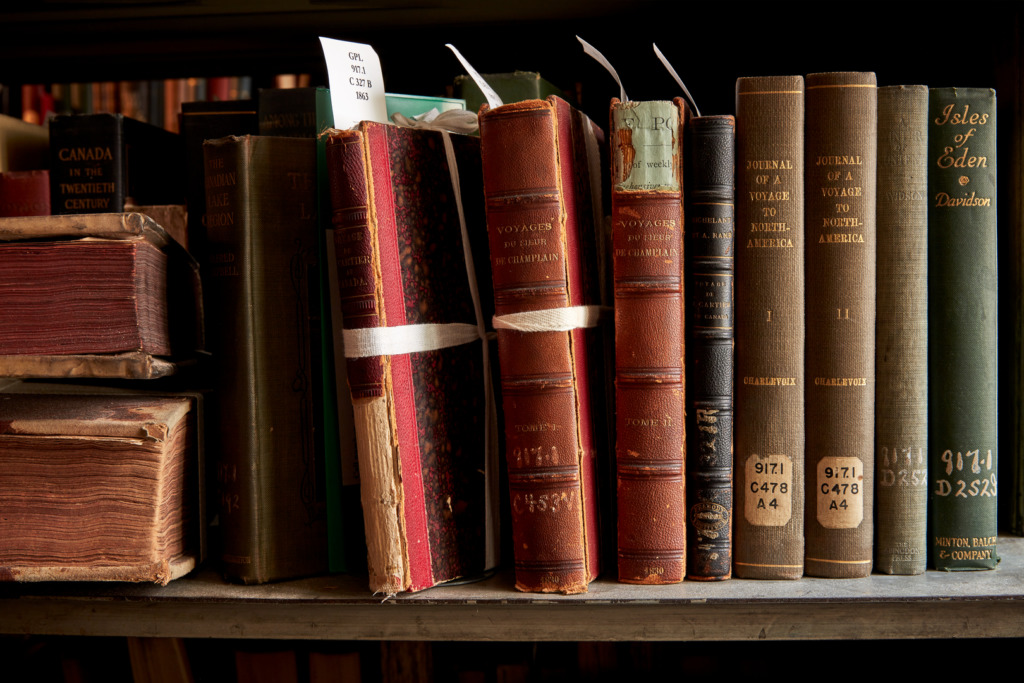
Baltimore CityLit Festival
The CityLit Project is dedicated to elevating enthusiasm for literary arts in the Baltimore area. Each year, the organization hosts a daylong celebration of literature in partnership with local arts and literary groups such as the Enoch Pratt Free Library, Chesapeake Shakespeare Company and the Baltimore Symphony Orchestra. In addition to bringing well-known authors to Baltimore, the festival showcases Baltimore’s diverse community of self-published authors, small presses and literary journals and organizations.
